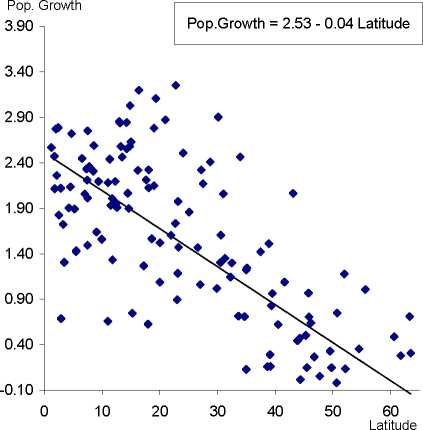parental income spend on child health care is more effective (in the sense of preventing death)
in a geographically unfavorable location.
The debate whether geography matters directly for economic performance (e.g. through labor-
and land productivity) or just indirectly through its effect on institutions is still open.2 The
present article does not contribute to this debate. Instead, it proposes a second indirect channel
through which geographic location may matter for economic development. This channel operates
through child mortality, health expenditure, fertility, and population growth.
Figure 2: Absolute Latitude and Population Growth, Year 2000

R2 = 0.506, data for 132 countries from World Bank (2004) and Masters and McMillan (2001).
Regression for 1960 (not shown): Pop. Growth = 2.96 - 0.03 Latitude.
A striking demographic fact - shown in Figure 2 - is that population growth tends to be higher
in geographically unfavorable regions. While biologists might be puzzled by the observation that
a species multiplies at higher rates in environments for which it is less fit to live in, demographers
and economists provide answers. A seemingly obvious explanation is the demographic transi-
tion according to which fertility rates follow a decline of mortality with delay so that population
growth rises temporarily. Given that the demographic transition started earlier at geographi-
cally favorable locations, a negative correlation between latitude and population growth follows
2Besides Acemoglu et al. (2001), Rodrik et al. (2004), and Easterly and Levine (2003) provide evidence of a
predominantly indirect effect. See Glaeser et al. (2004) for a critical assessment of this literature. Bloom and
Sachs (1998), and Masters and McMillan (2001), Sachs (2003), and Olsson and Hibbs (2005) argue in evidence of
a direct effect of geography.
More intriguing information
1. The name is absent2. A Note on Costly Sequential Search and Oligopoly Pricing (new title: Truly Costly Sequential Search and Oligopolistic Pricing,)
3. Une Classe de Concepts
4. Optimal Vehicle Size, Haulage Length, and the Structure of Transport Costs
5. A Duality Approach to Testing the Economic Behaviour of Dairy-Marketing Co-operatives: The Case of Ireland
6. PROPOSED IMMIGRATION POLICY REFORM & FARM LABOR MARKET OUTCOMES
7. The name is absent
8. The name is absent
9. HOW WILL PRODUCTION, MARKETING, AND CONSUMPTION BE COORDINATED? FROM A FARM ORGANIZATION VIEWPOINT
10. The name is absent